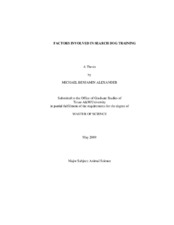| dc.description.abstract | Events of significant impact as recent as hurricane Ike yielded a consistent disturbing truth: we lack sufficient numbers of competent search dog [Canis familiaris] teams. This study was conceived to provide information in identifying factors involved in training competent search dogs. Obedience training methods, age training was initiated, previous handler canine training experience, and handler perception and emotional attachment to their search dog were examined through a sixty-six question survey. Achievement of a national certification was used as a measure of performance success. Association between factors and performance success was evaluated through Chi-Square testing. Surveys were announced through the National Search Dog Alliance (NSDA) and were available online; 177 were fully completed by respondents and used in the data analysis.
Seventy-two percent of nationally certified canine team respondents preferred positive reinforcement methods. Several statistically significant associations were detected: (a) female handlers preferred positive reinforcement training methods [x^2 = 8.504, d.f.=1, P = 0.004], (b) as dogs matured use of active training equipment increased [x^2 = 54.043, d.f.= 2, P < 0.001]., and (c) four hours or more time spent training each week had a higher proportion of national certifications [x^2 = 16.379, d.f. = 1, P less than 0.001]. The data also indicated a trend for handlers to have previous canine training experience equal to or greater than search dog training experience [x^2 = 118.36, d.f. = 9, P =0.05]. The results warrant further research on the effects of early training, the effects of training time investment, and the interaction between canine selection and handler understanding of canine learning theory. | en |


